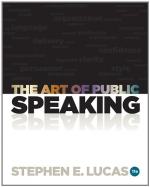The worldly hope men set their
hearts upon—turns ashes—or it
prospers;—and anon
like snow upon the desert’s dusty
face—lighting a
little hour or two—is gone.
The bird of time has but a
little way to flutter,—and the bird
is on the wing.
You will note that the punctuation marks have nothing to do with the pausing. You may run by a period very quickly and make a long pause where there is no kind of punctuation. Thought is greater than punctuation. It must guide you in your pauses.
A book of verses underneath
the bough,—a jug of wine, a loaf of
bread—and thou
beside me singing in the
wilderness—Oh—wilderness
were paradise enow.
You must not confuse the pause for emphasis with the natural pauses that come through taking breath and phrasing. For example, note the pauses indicated in this selection from Byron:
But hush!—hark!—that
deep sound breaks in once more,
And nearer!—clearer!—deadlier
than before.
Arm, ARM!—it
is—it is the cannon’s opening roar!
It is not necessary to dwell at length upon these obvious distinctions. You will observe that in natural conversation our words are gathered into clusters or phrases, and we often pause to take breath between them. So in public speech, breathe naturally and do not talk until you must gasp for breath; nor until the audience is equally winded.
A serious word of caution must here be uttered: do not overwork the pause. To do so will make your speech heavy and stilted. And do not think that pause can transmute commonplace thoughts into great and dignified utterance. A grand manner combined with insignificant ideas is like harnessing a Hambletonian with an ass. You remember the farcical old school declamation, “A Midnight Murder,” that proceeded in grandiose manner to a thrilling climax, and ended—“and relentlessly murdered—a mosquito!”
The pause, dramatically handled, always drew a laugh from the tolerant hearers. This is all very well in farce, but such anti-climax becomes painful when the speaker falls from the sublime to the ridiculous quite unintentionally. The pause, to be effective in some other manner than in that of the boomerang, must precede or follow a thought that is really worth while, or at least an idea whose bearing upon the rest of the speech is important.
William Pittenger relates in his volume, “Extempore Speech,” an instance of the unconsciously farcical use of the pause by a really great American statesman and orator. “He had visited Niagara Falls and was to make an oration at Buffalo the same day, but, unfortunately, he sat too long over the wine after dinner. When he arose to speak, the oratorical instinct struggled with difficulties, as he declared, ’Gentlemen, I have been to look upon your mag—mag—magnificent cataract, one hundred—and forty—seven—feet high! Gentlemen, Greece and Rome in their palmiest days never had a cataract one hundred—and forty—seven—feet high!’”




